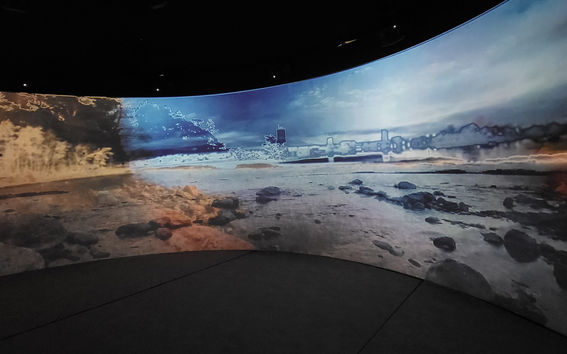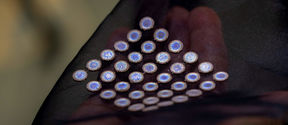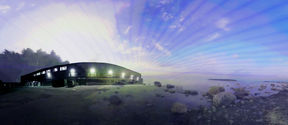Designs for a Cooler Planet
Visit Designs for a Cooler Planet festival in Otaniemi on 6 Sep – 3 Oct 2024 to challenge your perception of the possible.

‘People say that it’s always dark in Helsinki in the winter, but if you pay attention, you realise that it’s not,’ Mathias Schach tells me. ‘The nightglow is so strong that there’s always this thick layer of yellowish gooey light, so it’s never really dark.’
Schach and fellow student Monika Hauck are working on a project to fix that. Their exhibition, part of Designs for a Cooler Planet 2023, aims to raise awareness of urban light pollution and empower people to tackle the problems it causes.
‘Light pollution is sort of invisible and doesn’t get talked about nearly as much as other environmental problems, but it has a strong impact on us and our environment,’ says Hauck. Research shows that artificial lighting can disrupt our sleep rhythm, increasing health risks and reducing wellbeing.
But it’s not just about the quantifiable risks and benefits. As I talk with the young artists, all three of us recall the deeper, darker skyscapes of our childhood. ‘I’m originally from Canada, and I used to be able to just go into my backyard and see the Milky Way,’ says Hauck. ‘You certainly can’t do that anymore.’
Schach grew up under the starry skies of rural Austria. ‘I was used to seeing the night sky – not really the Milky Way, but definitely more sky than in Helsinki,’ they recall. ‘With advertisements and showrooms lit during the night now, what does that mean for human and non-human life? We didn’t have that much light even 100 years ago, and now it’s everywhere.’
For Hauck, ‘the important thing as an artist is that the work I do can bring about a positive change. I’m trying to evaluate methods to create an emotionally and intellectually immersive environment that would stay with people and encourage them to make a change in their life or shift their behaviour.’
When Schach suggested preparing an installation about light pollution for Designs for a Cooler Planet, Hauck saw it as a great opportunity to develop that approach, and the project fit well with her overall research for her thesis. ‘It’s an excellent way to test out these tools instead of waiting until after school to do this kind of art,’ she says.
Monika HauckEven if things seem good enough, there are still ways to make improvements at an individual, community and governmental level.
The exhibition is an interactive, immersive video installation that shows the extent of light pollution in different areas around Helsinki and lets people experience what things could be like instead. Although the duo are also interested in how urban light pollution affects other animals, that remains a background element in this exhibition, which focuses on showing visitors possibilities and pathways to change. ‘The idea is to give people a sense of how things are now and what could be done better,’ says Hauck.
Visitors will also learn how they can make that change happen. Hauck says the goal isn’t to remind people to switch off their lights but ‘to encourage civic activity and provide enough information for people to take action.’
Schach offers a familiar example: sports fields at schools that are brightly lit throughout the night. ‘Is that necessary?’ they ask. Regulations about lighting in outdoor public spaces already exist, but they’re often poorly enforced. ‘We’ve collected stories of people who successfully dealt with light pollution in their surroundings – for example, lobbying through the housing association to enforce what was already legally required.’
The goal is to raise awareness and show that change is possible, Schach says. ‘It actually doesn’t take much effort to reduce light pollution.’
The idea of dimming public lighting or controlling it with sensors is rooted in a different approach about where and how lights are used. ‘To make the cycling and pedestrian paths in Vienna safe, they have LEDs equipped with motion detectors, so they gradually lighten as someone approaches and then dim as people move away,’ says Schach. ‘That’s a great example of an intentional and purposeful approach to lighting.’
Public lighting is important for people to feel safe, but it should be used effectively. ‘One of the issues is where public lighting infrastructure should exist and where it shouldn’t. There are dramatic discrepancies between where there’s too much light and not enough,’ says Hauck.
Working on the project has already changed their relationship with lighting. ‘I’ve developed a heightened sense of awareness about it. I’m paying more attention and raising things with our neighbours,’ says Schach. ‘I also look at my surroundings differently. I notice the types of lamps on the street or in parking lots, especially when a different model should be used.’
Coming here from Canada, Hauck feels that Finland ‘is better in most ways,’ but she worries that this can lead to complacency – that people don’t want to make a fuss when things are working fairly well. ‘The micro-awareness I’ve gotten through this project has been a reminder that complacency is one of our greatest weaknesses,’ she says. ‘Even if things seem good enough, there are still ways to make improvements on an individual level, on a community level, and at the governmental level.’
Hauck and Schach hope their installation will prompt visitors toward similar reflection and give them the tools to take the next steps. When I ask what an ideal outcome would be, Hauck responds, ‘people taking action to get regulations enforced and maybe suggest areas where lighting could be improved or adjusted. Once some property managers have changed their behaviour, there could be a snowball effect building on those precedents to get others to do the same thing. Ideally, that would change the landscape of public spaces.’
In the long run, the two imagine expanding the project to look more deeply into how lighting affects non-human animals and the environment around us. For the moment, those elements are part of the installation but not its focus, though they were an important part of the process. ‘Making the timelapses meant a lot of waiting, usually just the two of us. Just being able to sit in nature and observe and have great conversations about these questions…those were some of my favourite moments,’ recalls Hauck.

Visit Designs for a Cooler Planet festival in Otaniemi on 6 Sep – 3 Oct 2024 to challenge your perception of the possible.

Experience the night sky without light pollution.







